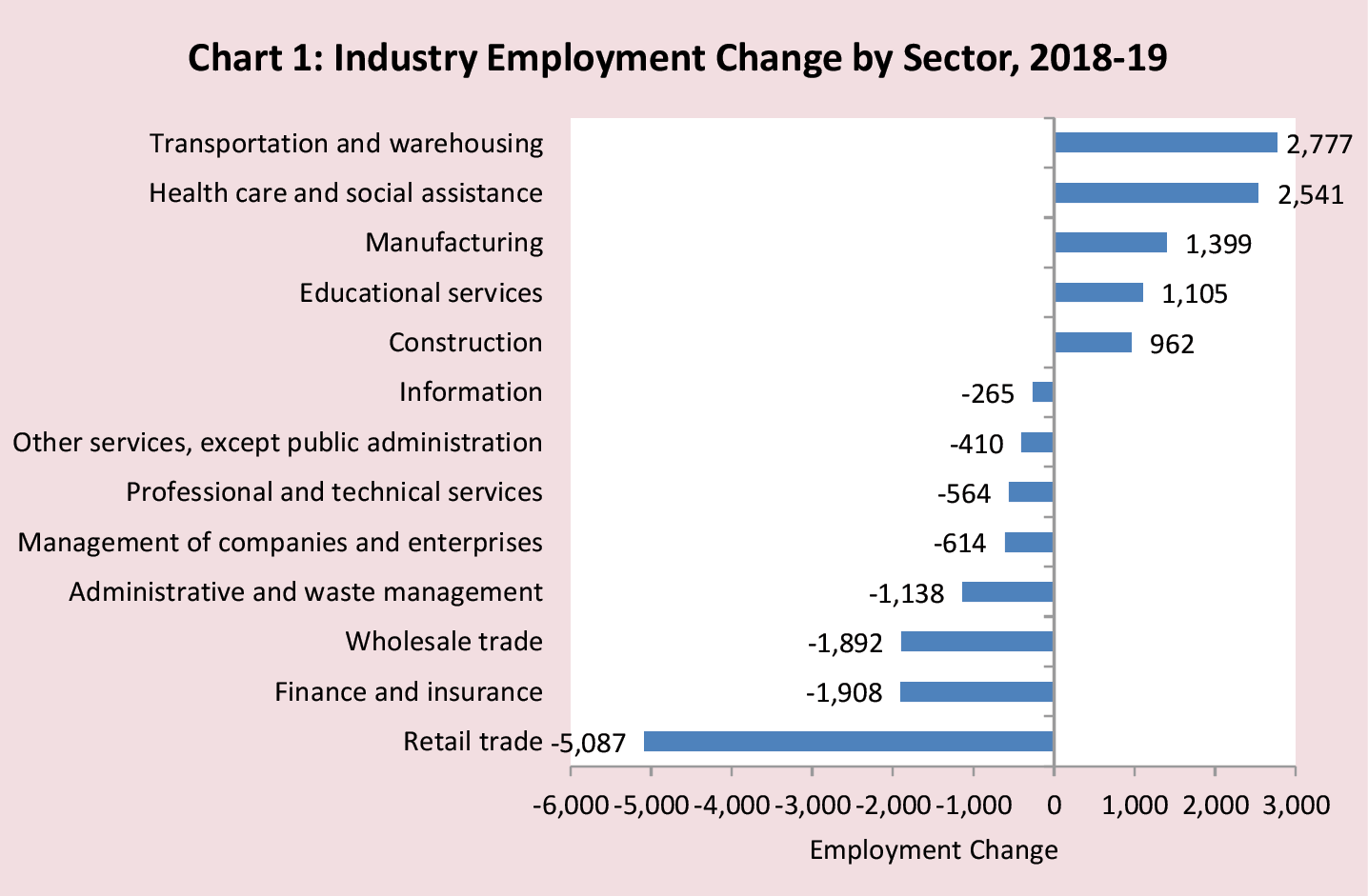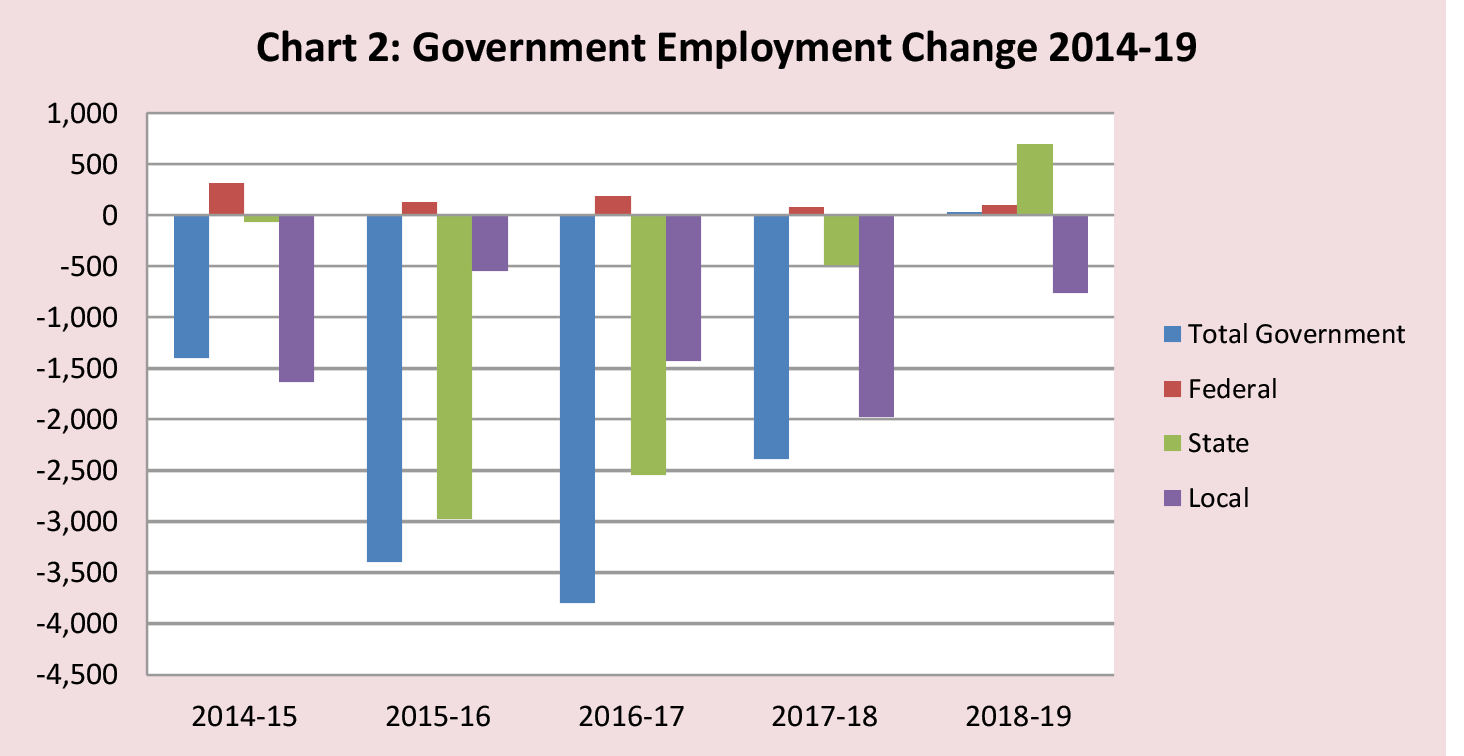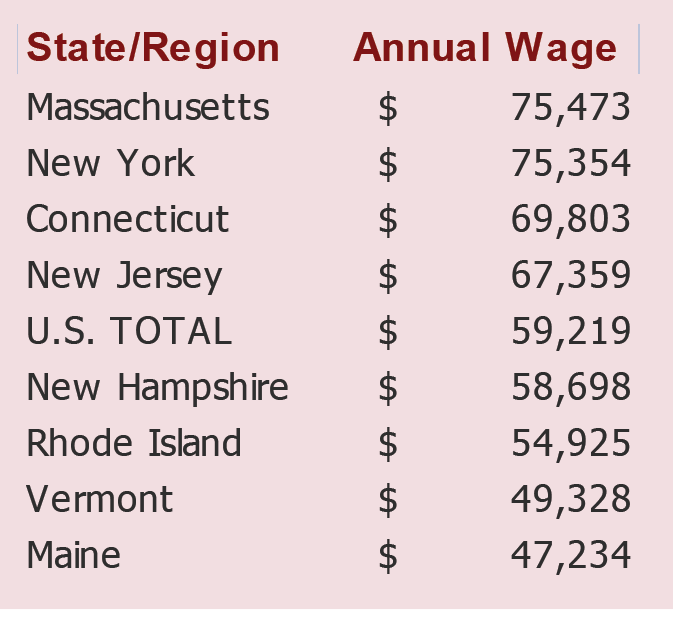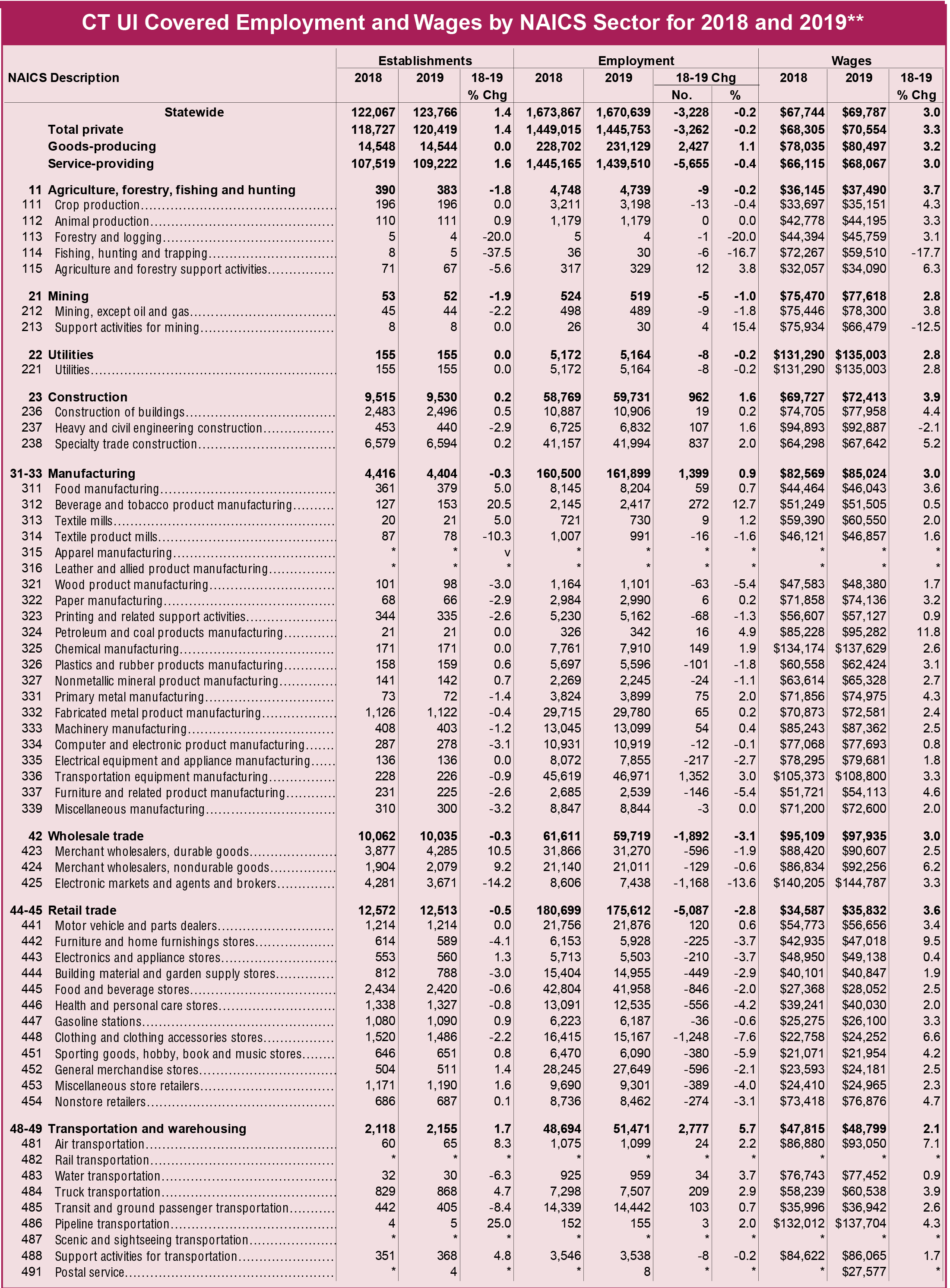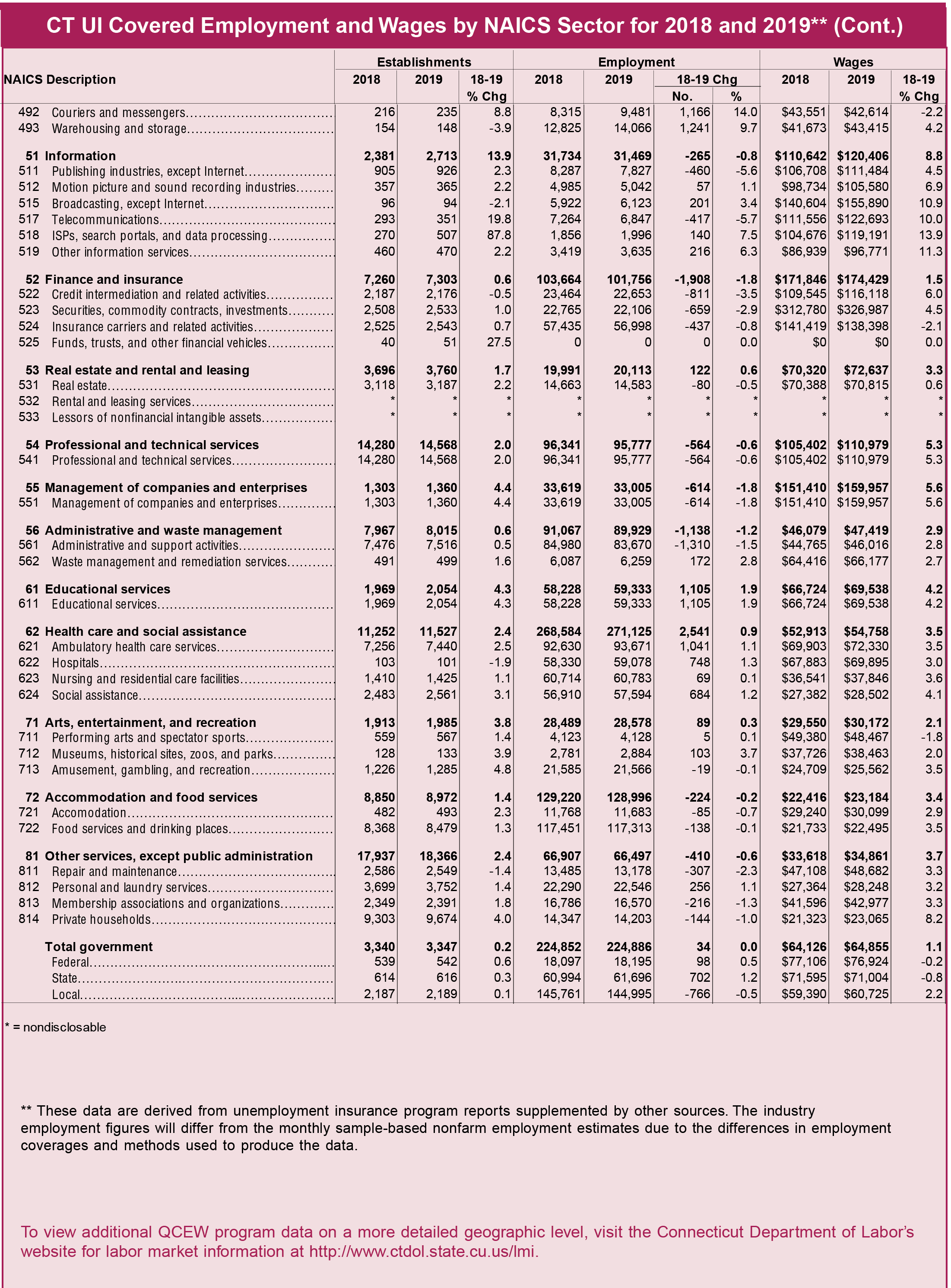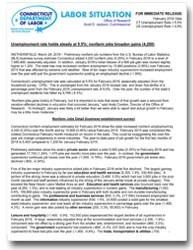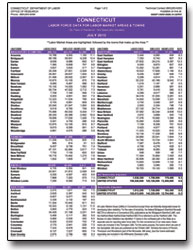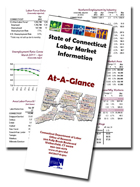Covered Employment and Wages: A 2019 Annual Review
By Jonathan Kuchta Jonathan.Kuchta@ct.gov, Research Analyst, Connecticut Department of Labor
 ccording to the most recent data published by the Quarterly Census of Employment and Wages (QCEW) program, the number of jobs in Connecticut decreased by 0.2 percent during 2019.
ccording to the most recent data published by the Quarterly Census of Employment and Wages (QCEW) program, the number of jobs in Connecticut decreased by 0.2 percent during 2019. Connecticut reversed the pattern of slow but steady employment growth since the Great Recession toward the end of 2019. Total private industry employment, constituting 86.5 percent of the state’s employment total, decreased by 0.2 percent. Total government employment held steady year-over-year.
Connecticut reversed the pattern of slow but steady employment growth since the Great Recession toward the end of 2019. Total private industry employment, constituting 86.5 percent of the state’s employment total, decreased by 0.2 percent. Total government employment held steady year-over-year.
Average annual wages for all Connecticut jobs increased by 3.0 percent, to $69,787, nearly double the improvement on the increase in 2018. In 2019, private sector wages increased by 3.3 percent to $70,554; government wages increased 1.1 percent to $64,855.
The number of business establishments continued their expansion, with a new total of 123,766, an increase of 1.4 percent over 2018. Total private establishments represented nearly all of the increase, reaching 120,419 in 2019. Government worksites increased 0.2 percent in the state, from 3,340 in 2018 to 3,347 in 2019.
Employment Looking at the sectors with notable gains in 2019, several industries continued to improve from their 2018 levels. The transportation and warehousing, health care and social assistance, and manufacturing sectors all showed solid increases. Transportation and warehousing was the largest gainer last year, expanding by 2,777 jobs (Chart 1). This continued the expansion of this sector, growing 5.7%. The health care and social assistance sector saw marked growth over the past year, nearly equaling transportation gains with 2,541 jobs added. Manufacturing showed continued improvement in 2019, gaining 1,399 jobs.
For sectors that declined in 2019, retail trade dropped the most, with a significant loss of 5,087 jobs, nearly twice the drop in 2018. The finance and insurance and wholesale trade sectors continued their declines as well, dropping 1,908 and 1,892 jobs, respectively. Government employment experienced almost no change, up by 34 jobs (Chart 2). See pages 3 and 4 for data on other industry sectors and subsectors.
While there may not have been much net change in government employment, local government continued to shrink, down 766 positions. Most of this decline occurred in the accommodation and food services sector, down 4.7%. State government saw most of the increase in educational services, though public administration also saw a 2.3% increase.
The Bureau of Labor Statistics (BLS) aggregates the North American Industrial Classification System (NAICS) sectors to form the top level goods-producing and service-providing “domains”. Goods-producing sectors include agriculture, forestry, fishing, and hunting; mining; construction; and manufacturing. The remaining sectors are aggregated into the service-providing domain.
For 2019, the goods-producing domain encompassed 13.8 percent of total covered employment, with the remaining 86.2 percent in the service-providing domain. The goods-producing employment grew by 2,427, or 1.1 percent, with service-providing employment shrinking by 0.4 percent, or 5,655, at the same time.
Wages Connecticut average annual wages varied greatly between industries and within each sector in 2019. It should be noted that much of this difference in pay level can be attributed to factors such as hours worked (full- or part-time), workforce composition, wages, including bonuses or stock options, and seasonal and weather-related influences.
The highest annual average wage, found in the finance and insurance sector, was $174,429 - 2.5 times the state average. Those in the securities, commodity contracts and investments subsector earned an average of $326,987 in 2019. The management sector was not far behind finance and insurance at $159,957. Overall, wages showed improved growth in 2019, at 3.0%, with four sectors showing more than four percent growth.
At the other end of the spectrum, accommodation and food services workers earned the least, at $23,184. This increase of 3.4% was greater than the state average, though it is heavily influenced by part-time workers. Next were arts, entertainment and recreation at $30,172 and other services, except public administration at $34,861 in annual wages.
2019 was a solid year for wages in general, as all sectors experienced some wage growth, an improvement over prior years. Goods-producing wages showed an increase of 3.2 percent compared to 2018, at $80,497. They are 15.2 percent above the annual average for all industries. Service-providing wages experienced growth, rising to $68,067, an increase of 3.0 percent on an annual basis. Connecticut continues to maintain comparable annual wages to nearby states in the Northeast, coming third behind only Massachusetts and New York (Table). Average wages in Connecticut are 17.9 percent above the U.S. average, declining slightly from last year’s 18.3% premium.
 |


















